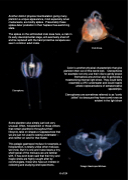DiveMindanaoInauguralFINAL.pdf
Another distinct physical manifestation giving manyplankton a unique appearance, most especially larvalcrustaceans, are bodily spikes. Presumably thesespikes deter predation in their hapless free-swimmingstate.The spikes on the soft-bodied crab zoea here, a crab inits early developmental stage, will eventually shed offand be replaced with the hard protective carapace wesee in common adult crabs Ctenophore.Crab Zoea.Color is another physical characteristic that giveplankton their out-of-this-world look. Ctenophoresfor example not only use their cilia to gently propelthemselves around but also to generate amesmerizing internal light show. They could fairlyresemble a UFO underwater and could inspireartistic representations of extraterrestrialspaceships.Ctenophores are sometimes referred to as “combjellies” too because they have comb rows asevident in the light show Some plankton also simply just look veryunusual. Often, holoplankton or those crittersthat remain planktonic throughout theirlifecycle, take on shapes or appearances thatwe are just not used to seeing underwater –and neither on land for that matter.This pelagic gastropod mollusc for example, aholoplankton, is totally unlike other molluscswe know. But it is one and it also bears a tinyshell typical of the molluscs we are familiarwith. It has even been said that their tiny andfragile shells are highly sought after byconchologists, those who have an interest incollecting and studying shell specimens.Pelagic Gastropod Mollusc.6 of 24
